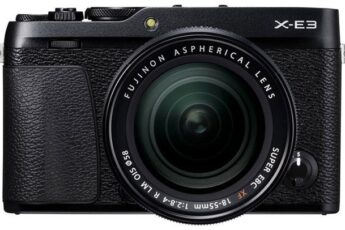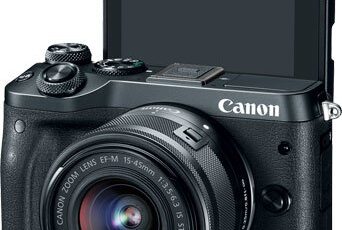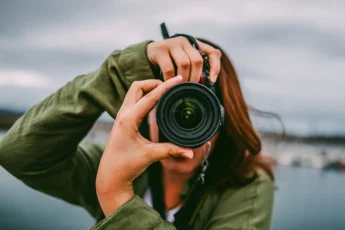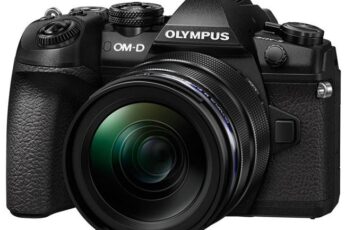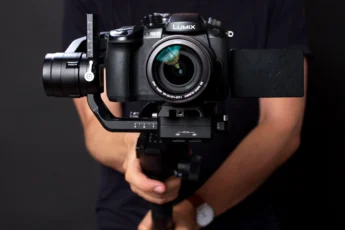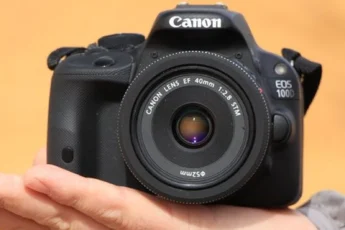DSLR cameras still represent the majority of camera purchases. But the intriguing features of mirrorless cameras are slowly stealing customers away with each passing year. Mirrorless cameras are the newest digital camera type. They don’t have dedicated autofocus systems or optical viewfinders like DSLR cameras have. Instead, the sensor generates a preview image with the LCD panel or an electronic viewfinder. And the autofocus system is integrated into the sensor as well. As a result, the bodies of mirrorless cameras can be smaller without all of these extra mirrored systems.
The downside is that all of these extra sensor functions tend to drain battery life much more quickly. They also use smaller batteries to keep the camera compact, which further compounds the stamina problem. But many photographers find the tradeoffs more than worth it. The Fujifilm X-A3 is a mirrorless camera that’s marketed towards beginners and intermediate level photographers. Let’s take an in-depth look at this camera.
Tired of reading reviews?
- Technical Specifications
- Build Quality
- Image Quality
- What additional features does the Fujifilm X-A3 have?
- Film Simulation Modes
- In-Camera Image Editing
- Continuous Drive Capacity
- Videography Features
- How does the Fujifilm X-A3 compare to the Olympus OM-D E-M10 Mark III?
- Advantages of the Fujifilm X-A3
- Advantages of the Olympus OM-D E-M10 Mark III
- How does the Fujifilm X-A3 compare to the Fujifilm X-A10?
- Which photographers should consider the Fujifilm X-A3?
- Conclusion
Technical Specifications
- Price: $295.00 with kit lens
- Kit Lens: XC 16-50mm F3.5-5.6 OIS II. “XC” stands for the particular lens class. The XC series is usually lower priced than Fujifilm’s XF series. OIS refers to the optical image stabilization built into the lens to negate hand shake while shooting. “II” means this is a second generation design for Fujifilm’s optical image stabilization systems.
- Sensor: 24.2 MP sensor (APS-C sized 23.5 x 15.7 mm)
- Number of Autofocus Points: 77 Contrast detection points. Contrast detection uses the image generated by the sensor to search for maximum contrast. The AF system searches for the highest possible tonal difference between image pixels.
- Built-In Flash: Yes, with 7.0 meter (23 foot) range at ISO 100. By increasing the light sensitivity, you can increase the flash detection range.
- Continuous Shooting: 6 frames per second
- ISO Range: 200-6,400 with a digital drop to ISO 100 and digital boosts to ISO 12,800 and 25,600. Digital drops are a form of improved noise control that allow the camera to shoot in especially bright light. While digital drops are useful, digital boosts unfortunately create more noise than native ISO 12,800 and 25,600 would. They rarely generate usable images at this high an ISO value.
- Video Recording Capability: Full HD 1920×1080 (60, 50, 30, 24 fps), HD 1280×720 (60, 50, 24 fps)
- Image Format: JPEG and RAW. JPEG is the format used for displaying photographs on a computer or smart device. Being a compressed format, JPEGs sacrifice some image data to take up less space on hard drives. RAW files are uncompressed and contain all of the original image data of the camera. RAW files are much larger than JPEGs and are only readable by the camera and computer image editing software. But for any post-shoot image editing, RAW files provide the best possible image quality.
- Wireless Connectivity: Yes via Wi-Fi. Using the FUJIFILM Camera Remote app, the X-A3 can connect to smart devices. This allows the smart device to remote control the camera. The app also allows you to send photos straight to your smart device. The camera can also connect directly to the instax SHARE Smartphone Printer SP-2 to print photos without a computer.
- Supported Memory Cards: SD, SDHC, SDXC, UHS-I
- Battery Life (CIPA Rating): 440 images per charge
- Weight: 339 g (0.75 lb / 11.96 oz)
- Dimensions: 117 x 67 x 40 mm (4.61 x 2.64 x 1.57 in)
Build Quality
Fujifilm cameras tend to have a classic film camera look to them, and the X-A3 is no exception. The compact metallic outer casing and leather textured grip give it an attractive look. The grip is fairly shallow, which will appeal to people who prefer a sleek feel to their cameraю. Let us introduce you FManuals.com website – the largest online library of user manuals.
The X-A3 has the usual Mode dial on top with Program, Manual, and the other exposure control settings common to interchangeable lens cameras. It has a main command dial for adjusting shutter speed and aperture, choosing menu options, and selecting images taken. And there’s a third sub-command dial just below the main dial that also adjusts shutter speed and aperture. The sub-command dial can also zoom in on images taken instead of selecting different images.
The X-A3 has a single customizable Fn button for users that aren’t satisfied with the placement of functions like ISO or video recording. While many mirrorless cameras have an electronic viewfinder, the X-A3 has none at all. Users have to use the 1,040,000 pixel LCD display to compose video and photographs. Some might prefer the larger display and not having to place the camera at eye level. But traditional photographers often find this style of shooting a bit annoying to work with. The LCD is touchscreen-enabled for selecting autofocus points and shooting images. It also tilts up to 180 degrees to allow users to take selfies with the camera, but is not fully articulating.
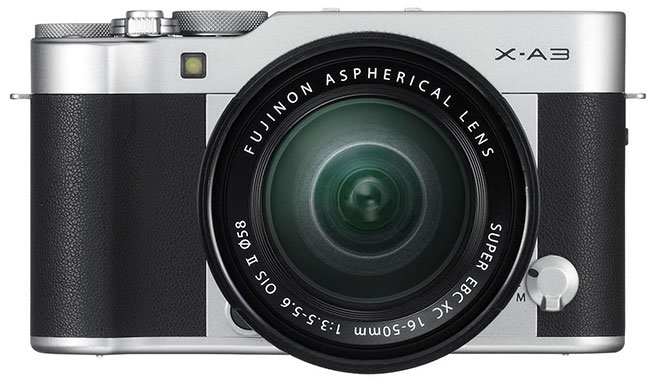
Image Quality
The X-A3 has an APS-C sensor (sized 23.5 x 15.7 mm) which is larger than that of most digital cameras. Only full-frame sensors (sized 36 x 24 mm) are larger. Larger sensors are generally preferred over smaller ones. This is because the larger sensor area creates more surface area for light collection. And having more light means the camera can better control image noise and depth of field. Depth of field is how much of a scene is in sharp focus. Narrow depths of field are harder to create with tiny sensors. Photographers looking for sharp subjects and fine bokeh (out of focus artifacts) will find the X-A3 sensor does a fine job with the right lens.
With 24 megapixels of resolution, the X-A3 can create images that can be printed at up to 20″ x 13″ at 300 pixels per inch. Combined with the in-lens image stabilization, the X-A3 is a great portrait camera. Another portrait-oriented feature is the 77-point contrast detection autofocus system. Contrast detection works by analyzing the image being generated by the sensor for optimum contrast. The more intense the tonal differences are between individual pixels, the more contrast the image contains. While the less in-focus the image is, the more similar the tones across pixels will appear. Contrast detection can be slow at times, especially when the lighting is not ideal. But it is very accurate, which matters when trying to focus on the eye or nose of a portrait subject.

What additional features does the Fujifilm X-A3 have?
Film Simulation Modes
The has 11 Film Simulation modes that work similarly to the color profiles offered by Canon, Nikon, and other manufacturers. These brands tend to use Standard, Vivid, Monochrome, and a few others. Fujifilm’s are tailored to duplicate film effects, and offer greater specialization over the color profiles of other manufacturers.
Astia is the Soft Color setting which keeps bright colors from competing with the main subjects. Provia is the Standard setting and is designed to create true to life colors. Velvia works similarly to the Vivid setting of other cameras and brings out extra color saturation. Velvia is well suited for nature photography. Classic Chrome combines color softening with deepened contrast for a documentary film styling.
ProNeg High slightly increases color contrast for images to be processed later with additional software. This is useful for landscape photos. ProNeg Standard is similar but better for images with softer colors, such as studio portrait photography. Sepia is another old fashioned film appearance still used by many photographers today. Monochrome is black and white, same as any other camera. But Monochrome +Ye filter slightly increases the contrast, while Mono + R filter increases contrast even more. Both styles are great for toning down the brightness of the sky. Lastly, Mono + G filter gives a better balance with skin tones in black and white images.
In-Camera Image Editing
The Fujifilm X-A3 has remarkable flexibility in how the user can manipulate images post-shoot. The X-A3 can convert RAW to JPEG in-camera while preserving the original RAW files. JPEG images can also be cropped, resized, and Film Simulations can be added to the new files.
Push/Pull Processing adjusts the light exposure levels as desired. And Dynamic Range can enhance details that would be lost in bright highlights or dark shadows. If you don’t want to adjust both at once, Highlight Tone works specifically on bright highlights. And Shadow Tone adjusts darker portions of the image. White Balance and WB Shift make either broad or fine adjustments to the white balance of the image. White balancing is meant to remove unrealistic color tones so that white objects in real life appear white in our photos. Color adjusts color density while Sharpen works to clean up the edges of each subject.
The X-A3 also includes Noise Reduction to clean up image grain from low light settings. All of these tools allow the user to alter and improve images without needing to upload them to a computer.
Continuous Drive Capacity
The maximum image burst rate of the X-A3 is fairly average at 6 frames per second. But this speed is disappointing when you consider that it only lasts for 10 shots according to the manual. When stopped down to 3 frames per second, the X-A3 can take a total 50 shots before the camera buffer is overwhelmed. These numbers will change based on the image quality and speed of your SD card. Overall, the X-A3 is not a very good camera for shooting extended periods of fast action. However, casual action photographers may find this amount of burst photography to be plenty.
Videography Features
The video resolution of the X-A3 is average and not noteworthy. Full HD video (1920×1080) at up to 60 fps is acceptable video quality. But many cameras in this price bracket can shoot 4K video (3840×2160) which has four times the video resolution. Videographers will also find the lack of a dedicated microphone port a bit disappointing. But the hot shoe attachment allows for an external hot shoe microphone to be attached.
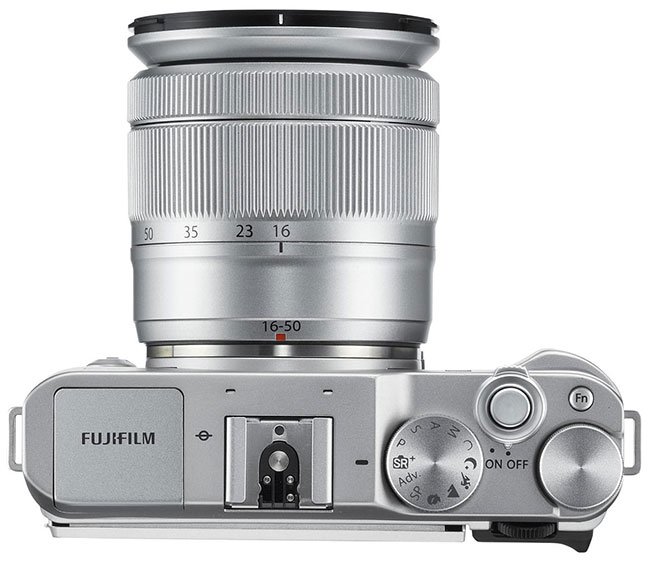
How does the Fujifilm X-A3 compare to the Olympus OM-D E-M10 Mark III?
The Olympus OM-D E-M10 Mark III is Olympus’s entry level mirrorless camera that also blurs the borders of intermediate level photography. Both are touchscreen-using mirrorless cameras with trim bodies and entry level pricing. How do the two cameras look side by side?
Advantages of the Fujifilm X-A3
Sensor Resolution: The X-A3’s 24.2 megapixels of resolution is 50% greater than the 16 MP of the Mark III. This is useful for users who need larger prints or do lots of cropping.
Battery Life: With up to 410 images per charge, the X-A3 has more stamina than the Mark III at 330 images per charge.
Advanced In-Camera Image Editing: The Mark III can convert JPEG to RAW and apply sepia, monochrome, and color saturation changes. It can also resize and make corrections to red eye, skin tone, and backlighting. But the X-A3 brings far more options to the table. It can perform all of these as well as crop images and apply each of the Film Simulation modes. It can also use Noise Reduction, Sharpening, adjust light exposure and white balance, and alter Highlight tone/Shadow tone as needed.
Advantages of the Olympus OM-D E-M10 Mark III
Video Resolution: 4K video (3840×2160) is slowly becoming the new standard in video resolution. A maximum of Full HD resolution with the X-A3 is somewhat disappointing.
UHS-II Memory Card Support: The Mark III can use the fastest SD cards, which is especially helpful when shooting RAW burst and 4K video. The X-A3 supports UHS-I but not UHS-II.
Number of Autofocus Points: The Mark III has 121 autofocus points versus 77 for the X-A3. This gives users even more flexibility in composition options.
Electronic Viewfinder: Unfortunately, the X-A3 does not have an EVF. All image and video composition is performed with the LCD panel. The Mark III has both an LCD and an EVF for those who prefer to compose photos and video the traditional way.
Number of Compatible Lenses: The X-A3 is compatible with 34 lenses. The Mark III is compatible with up to 90 lenses including the Panasonic Micro 4/3rds collection. Panasonic Micro 4/3rds lenses are compatible with Olympus bodies.
5-Axis Sensor Stabilization: The Mark III has image stabilization with any lens attached to the camera. The X-A3 only gains image stabilization if the lens has it preinstalled.
The Mark III brings a much better skeleton to the table as an entry level to intermediate mirrorless camera. And with its much larger lens collection to work with, upgrading to a more advanced body is more sensible. In-camera image editing is probably the most exciting advantage of the X-A3. But most photographers will be uploading their images to a computer no matter what. And even the X-A3’s in-camera editing pales in comparison to Photoshop, Lightroom, and any other standard photography software. The limited lens selection of the X-A3 combined with its relatively bland features make it the lesser choice here. However, it’s cheaper price tag of $295.00 is worth considering.
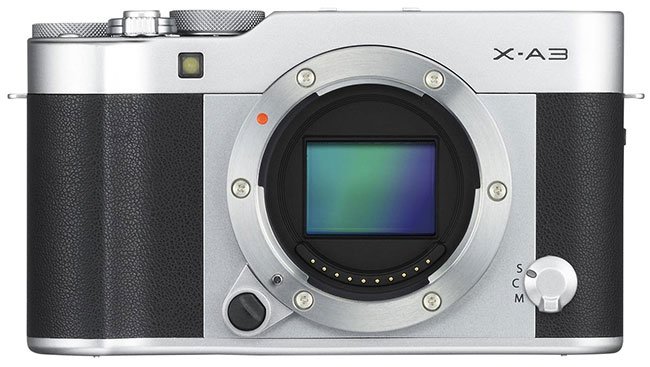
How does the Fujifilm X-A3 compare to the Fujifilm X-A10?
Price-wise, the X-A10 is a clear winner. Priced at with kit lens, it is one of the cheapest interchangeable lens cameras on the market. This makes it an even better bargain than the already cheap X-A3.
The X-A10 has the same sized APS-C sensor as the X-A3. But it comes with 16 MP of resolution instead of the 24.2 MP of the X-A3. This is both a benefit and a drawback. The drawback is that you have less resolution to work with when using the X-A10. But the benefit is that the pixels themselves are larger on the X-A10. Larger pixels have greater light gathering potential, which also improves noise reduction. The X-A3 has 28 more autofocus points than the X-A10 (77 vs 49) for extra flexibility in image composition.
Despite being a less expensive model, the X-A10 does not have an overly simplified design. It has all of same dials as the X-A3, including a customizable Fn button on top. While neither camera has an electronic viewfinder, the X-A10 does not have a hot shoe attachment. Photographers looking for additional light or wanting to attach an electronic viewfinder should stick with the X-A3. The hot shoe unit of the X-A3 allows you to add either of these options as needed. Both cameras have identical wireless options, video capability, battery life, and tilting LCD panels. The X-A3 is a modest upgrade over the X-A10 but does not outclass it entirely. And considering what other cameras have to offer in the $500-$700 mirrorless tier, it even feels slightly overpriced.
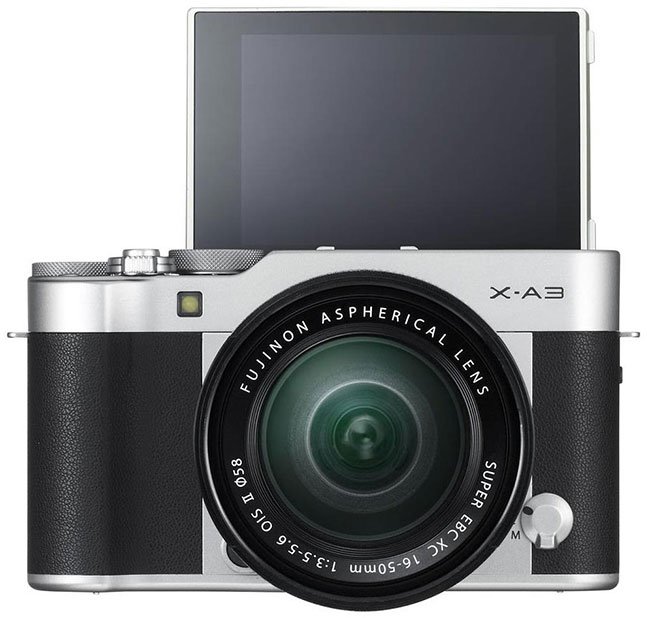
Which photographers should consider the Fujifilm X-A3?
The Fujifilm X-A3 caters to the beginner and intermediate level photography market. Absolute beginning photographers may find the design, with all of its dials and customization, slightly overwhelming. But it is still a very well designed camera and even beginners should grow into the X-A3 quickly. In terms of functions and capability, it is solidly an intermediate level camera.
With a large APS-C sensor, excellent image resolution, and macro-oriented kit lens, the X-A3 is especially appealing to macro and other photographers who love extreme close-ups. The kit lens of the X-A3 can focus on subjects as close as 7 cm when the lens is panned out to 16 mm.
The Film Simulation modes of the X-A3 work very well for photographers looking to create enhanced color profiles. Portrait photographers will also get a lot of mileage out of these modes. The in-lens image stabilization and contrast detection based AF system are also excellent for the sharpest possible portraits.
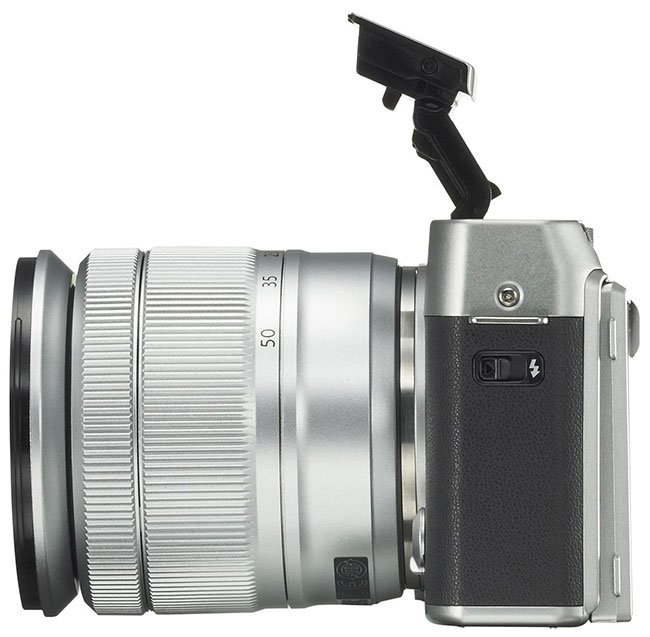

Conclusion
The X-A3 seems a bit underwhelming compared to some of the competition in this price tier. But it does have some solid features and does not have particularly poor performance in any category. The Film Simulation modes are intriguing for artists looking to create certain moods with the color profiles of their images. In-camera image editing is useful for new photographers that don’t have RAW editing software. But because most photographers will have computer software, it’s ultimately less exciting. The X-A10 also brings nearly all of the features of the X-A3 for almost half the price. Overall the Fujifilm X-A3 is an average mirrorless camera. It will certainly take fine images, but it doesn’t deliver quite enough to stand out from the pack.

